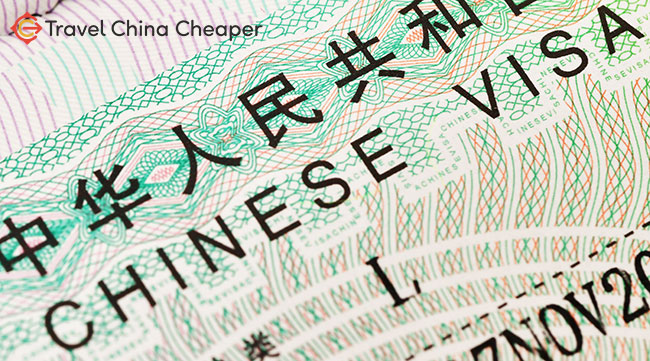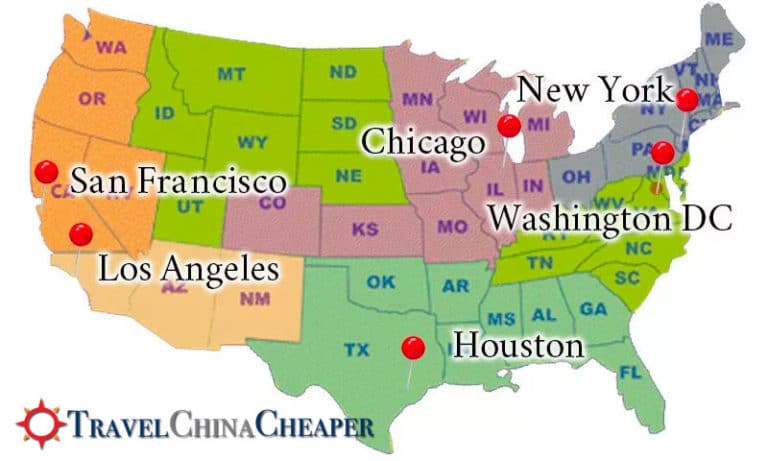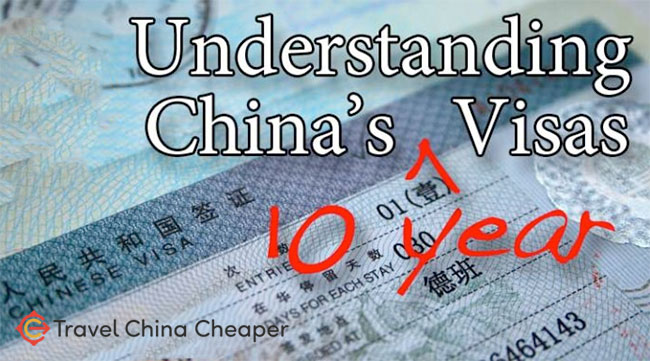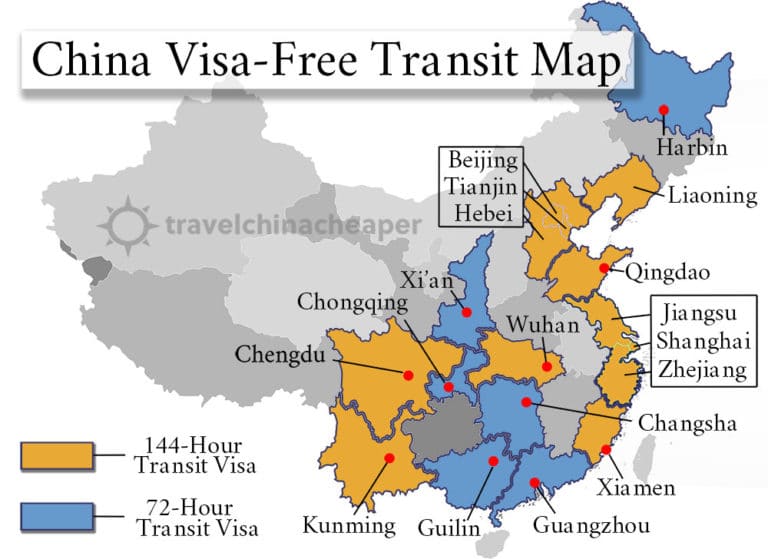Entering China visa-free? The 10-year China visa? Extending a China visa?? Understanding the Chinese visa process isn’t easy! It’s difficult to find all the information you need, much less in a single resource. There’s a lot to consider when applying for your visa to China and below I’d like to walk you through my 2020 travelers’ guide to China visas.

Regardless of whether you’re traveling for business, pleasure, schooling or visiting family, there is no way around it…you will need a visa in your passport to exit the airport, train station or cruise port in China.
So, how and where does one get a China visa? How much do they cost? What kind of visa’s are available?
This process may appear daunting but the first step is acquiring the proper information. That’s where this guide hopefully comes in handy!
You should note that this guide first appeared as a chapter in the China travel handbook, a book I’ve published on Amazon that is a “how to” guide for travel in the region and one of the best-selling books for first-time travelers to China.
Feel free to read through this entire guide or jump to a specific section using the menu links below:
Don’t Have time to Read this Guide?
I’ll send the PDF version of my Guide to Chinese Visas to your email to read whenever is convenient.SEND THE PDFI won’t send you spam. Unsubscribe at any time.Powered by ConvertKit
Who Needs a Chinese Visa?
Check if you need a visa here:
Chances are, if you’re reading this right now…you will need to get a Chinese visa.
The majority of people will require a visa although there are a few exceptions. You may not require a visa if:
- You are traveling through China on your way to your final destination and will be in the country no longer than 24 hours. In this case you must remain in your area of transit such as the airport, train station, or port. You cannot leave to visit the city.
- You are from Brunei, Singapore, or Japan and plan to conduct business, visit family, or vacation for less than 15 days. There are stipulations here, so check with your consulate to determine what they are.
- You are traveling to Hainan with an organized group of five or more people and plan to stay for no more than 15 days. In this case, the visa will technically be taken care of by the travel agency.
Perhaps you’ve heard of China’s visa-free transit policy. I’ll detail this more below, but I don’t include this in the list above because you will still receive a visa in your passport. The only difference between this and a traditional visa is that you can apply for this visa upon arrival.
Where Does One Get a Chinese Visa?
Where and how you apply for a Chinese visa varies depending on where you live.
In countries such as Denmark, Canada, and the United Kingdom, one can apply for a visa through the Chinese Visa Application Service Center or CVASC.
If you live in the United States, you will need to apply at the Chinese Consular Office, the location of which varies based on which state you reside.

Regardless of where you are applying, mailed applications are NO LONGER accepted
(*Edit: I’ve been told that mailed applications are accepted in Australia).
Applications need to be delivered directly to the CVASC or Chinese Consular Office. If it’s not an option to hand-deliver your application personally, you may have someone deliver it on your behalf such as a close friend or family member or even a good China visa service agency.
Also, it’s worth noting that China requires either an invitation letter from a business/agency or proof of round-trip flights and hotels in order to apply for a visa. This can present a problem for many people (i.e. those who will fly in but exit by train or bus) but there are creative ways to solve this flight/hotel problem for China visas.

How Long Does it Take to Get a Visa?
It generally takes around 4 business days to process an application if you have the proper documents. A passport that has no less than 6 month validity with blank pages is required as well as a passport sized colored photo attached to the completed application.
For an extra charge you can expedite delivery and receive your visa in 1 to 3 days (in some cases even 24 hours!), but this does not include the time it takes for your passport to be mailed to the consulate and can be very expensive.

**The above example is for reference only and is based on U.S. citizenship. Processing times and fees may vary depending on what service you use.**
What is the Cost of a Visa?
Fees can vary depending on where you are applying, your nationality, and required entries. One can expect to pay anywhere from $30 to $140 USD or more.
People from a certain number of countries such as Albania, Slovakia, and Bulgaria will not be charged a fee but if you are from the United States or United Kingdom, you can expect to pay the highest rate (since we charge the Chinese a high fee for their passports).
Instead of attempting to list all of the Chinese visa rates here, we suggest you check with a reputable visa service like Passport Visa Express.
Explanation of Each Type of Chinese Visa
There are a number of Chinese visas one can apply for. Which one you choose really depends on your reasons for traveling.
When applying for any visa it’s important to have a completed application with a passport sized photo as well as a passport that remains valid for no less than 6 months. Listed here are the different types of visas and the requirements for getting them.
China Tourist Visa (L) Explained
The Chinese L Visa is the most common visa and likely the one that any traveler will be getting.
If you are planning to vacation or visit family in China you will need to obtain a Tourist Visa. This is the only visa that an individual can apply for without help from a business, school, or government agency.

If you will be traveling with a tour group, the organization may obtain an L Visa for the entire group rather than everyone having their own individual visas. In this case, you will give all of your information to a travel agency and they will take care of the details for you.
For those of you who are traveling alone, you will need to give all of your information to the consular office.
In addition to filling out the application and having a valid passport, you will also need to present a photocopy of your plane ticket home from China. An employee of the consular office may also request hotel information for the entire duration of your trip.
If you are planning to stay with friends or family who live in China they will need to provide you with an invitation letter that includes their address, name, and the numbers of their resident permits and passports. You will want to have a copy of all of these documents.
The multi-entry tourist visa is the most popular amongst tourists and permits you 30 or 60 days in China. Multi-entry means that you can leave the country and come back on the same visa.
China usually does not issue tourist visas for longer than 60 days and if you require longer you’ll either need to work directly with the consulate or apply for a different visa.
China Business Visas (F and M) Explained
The F visa is for individuals invited to China for investigations, non-commercial exchanges, education, science related ventures, and health reasons.
Note: You will require an invitation from a business entity to obtain this Chinese visa.

The M visa is for individuals who travel to China for business. This visa does not allow you to work or be employed in China but rather allows you to conduct business or trades.
This visa requires that you have an invitation letter provided by a Chinese organization or company.
China Student Visa (X) Explained
There are two different types of student visas, X1 and X2. X1 allows students to remain in China for longer than 6 months while X2 only permits a student to stay for 6 months or less.

Both visas allow foreign students to study or perform fieldwork in China. The organization you are working with will provide you with a JW202 or JW201 form and a letter of admission which must be returned with the application.
Most schools, an example being ThatsMandarin, will do a lot of the visa legwork for you. X visas do not permit you to work in China although this may be an option in the near future.
China Work Visa (Z) Explained
If you want to work in China and get paid, you will need a Work Visa. It’s important that the company you are planning to work with is able to employ foreign workers and you need to meet certain requirements that qualify you as an expert in your field of work.
Most often foreigners employed in China teach English which is why many universities and schools are accredited to employ foreign employees (read more about how to get a Z visa by finding a job teaching English in China).
Remember: It is technically illegal to work for pay in China without a work visa and you can get deported for doing so.
Your employer is responsible for sending you the proper documents such as a Visa Notification Letter and Employee Permit. Initially this visa is only good for 30 days so it’s imperative that you apply for a Temporary Residence Permit when you arrive which has a maximum of 5 years.
Private Visits and Family Reunion Visas (S and Q)
The S visa or Private Visit Visa is relatively new and allows family members to visit loved ones who are working or going to school in China. Family members that are able to use this visa include siblings, spouses, in-laws, children, parents, and grandparents.
There are two different types of S visas: the S1 and S2. S1 permits family members to stay for more than 6 months while S2 is for shorter stays. If you are planning to stay for longer than 6 months you will need to apply for a Temporary Residence Permit shortly after you arrive.
The Q visa or Family Reunion Visa is for those wishing to visit family members who reside in China for a long period of time. The Q visa is for foreigners who have relatives who are Chinese citizens or have permanent residency.
This visa can also be used for individuals who are planning to participate in foster care or adoption. The length of this visa can range from 30 days to 180 days although you will have to apply for a Temporary Residence Permit if you wish to stay longer than 30 days.
China Resident Visas (D) Explained
Resident Visas are extremely hard to get (read: practically impossible). To apply for this visa you need to have lived in China for at least 5 years and contributed in a big way to investments and/or made a large amount of profits for China.
It’s also important that you have great connections and rapport with the establishment you are working with.
China Journalist Visa (J) Explained
There are 2 types of Journalist Visas, J1 and J2. J1 is for journalists who will be spending a substantial amount of time in China while J2 is shorter term. It’s a long process to get this visa which requires you to have a personalized invitation from the Chinese media and if you plan on bringing your own camera equipment, you can expect to jump over multiple hurdles.
How Does One Extend a Visa?
If you wish to change visas in China (for example, from a tourist visa to a work/student visa) you can do so without leaving the country but it will need to be done well before the expiration of your current visa.
You will need to apply for this at the Public Security Bureau Entry and Exit Administration Office or PSB.
Public Security Bureau = 公安局
When applying to extend your current visa – for example if you want to add another 30 days to your tourist visa – you will be required to supply a number of documents including a Health Certificate that was issued to you by hospitals, the China Entry-Exit Inspection, or the Quarantine Bureau.
China’s 10-Year China Visa
China’s 10 year visa has been around for about 5 years now. Those holding passports from a number of countries, including the U.S.A., the U.K. and many more, are now able to obtain a 10 year visa for both tourism (L) and business (M).

China’s 10-year visa allows you to enter and leave China as many times as you want within the 10 year period.
If you wish to apply for this visa, you need to have no less than one year validity on your passport. For those who don’t have a year remaining, you will be given a Chinese visa that is good for 1 year or less.
Once you have obtained the visa you are able to renew your passport if needed with no issues.
While most people who apply for this visa will be able to get it with no difficulties, the Chinese Consulate has the ultimate say in who gets it and the exact length of time the visa is good for.

The process of applying for and obtaining a Chinese Visa can be challenging and time consuming but knowing the necessary information can ease stress and help the process along.
You can learn more about the China 10-year visa here, but we recommend applying for it even if you don’t have any intention of returning to China. It’s the same cost and it could come in handy years down the road if you unexpectedly find reason to return.
China Visa-Free Transit (72 & 144 Hours)
Over the past few years, China has made great strides in introducing generous visa-free transit policies that allow travelers to enter through specific cities.
These visas can be broken up into two categories: 72- and 144-hour transit visas. You must apply for these visas at your point of entry and there are stiff penalties if you overstay these time restrictions.v

The problem with these transit visas (as they’re often called) is that they’re super-confusing. There are a number of very specific rules and regulations you must follow in order to be eligible for the transit visa, and failure to follow them means you will be turned around at the airport when you arrive in China.
It’s important that you do your reading on China’s visa-free transit policy. I’ve compiled as much of the most current information as I can on this subject and created a 2020 Guide to China’s Visa-Free Transit Policy. Check it out before you decide to use this option.

In the map above, you’ll see all the regions in China that offer either 72-hour transit visas or 144-hour transit visas.
Conclusion | Getting a Chinese Visa
Now you have a good understanding of what kind of China visa you’ll need to get and how long it will take to obtain it. The next step is to begin the process!
In many cases you’ll need to have already purchased your flight tickets in order to apply for a China visa (although there are ways around this).
Usually this means applying sometime between a month and three months before your scheduled departure.
Please leave any comments below and check here if you need help finding the best Chinese visa service that can help you gather the appropriate paperwork and submit it to the consulate.
Other Related Articles
5 Cheapest Ways to Get Money to China in 2020
Learn to Write Chinese | Best Tools for Students 2020
Best Shanghai Travel Guide Books for 2021 (rated & reviewed)

